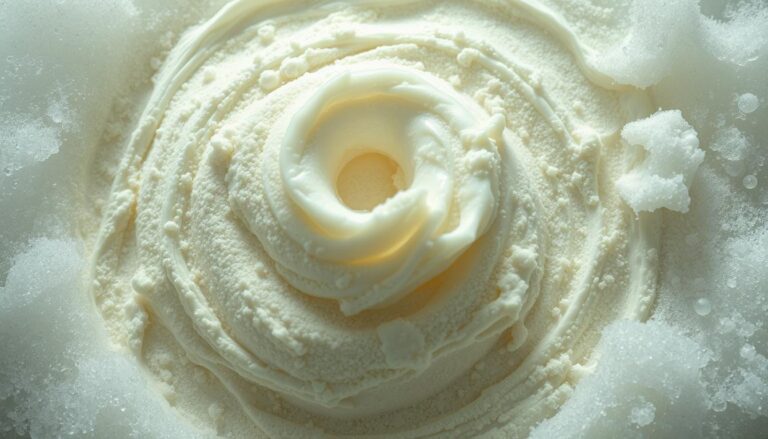What Kind of Toothpaste or Tools Do Dental Hygienists Use for Cleaning?
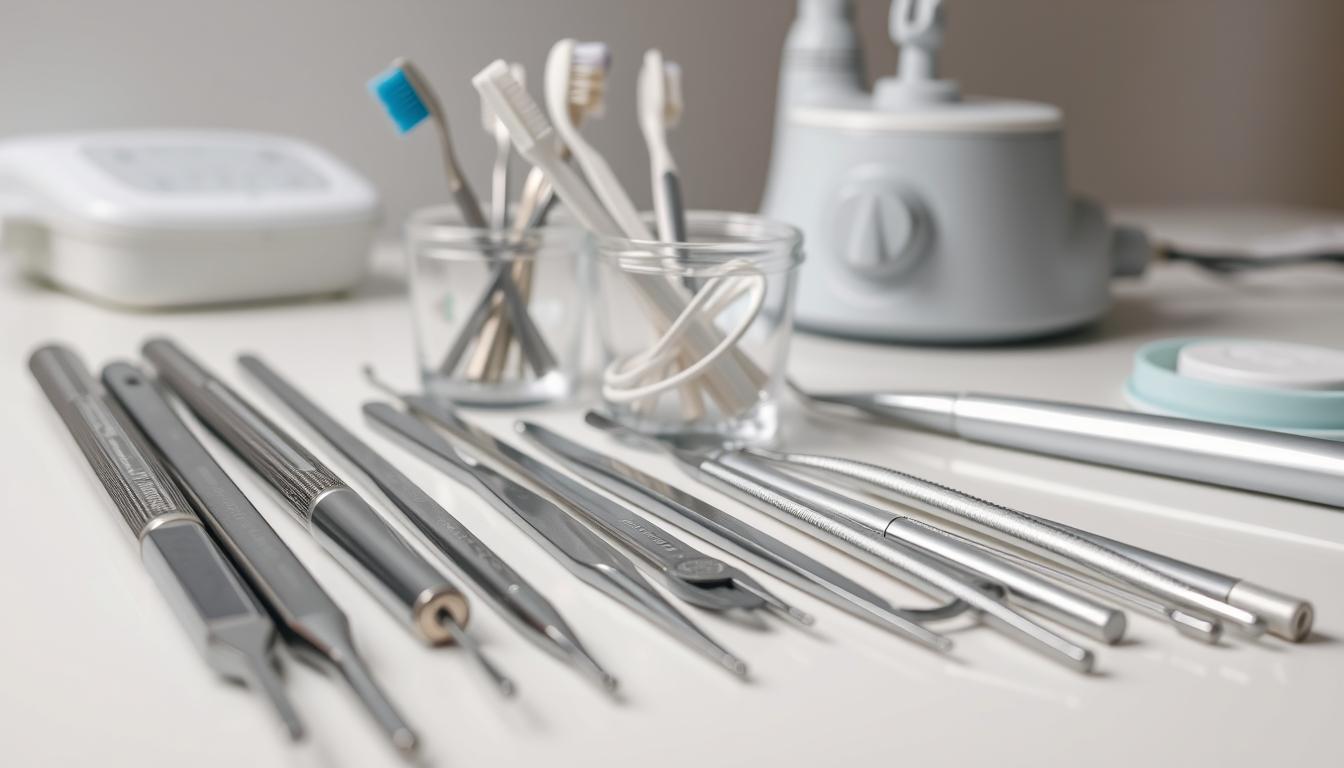
Could the choice of toothpaste or specialized tools truly shape your next dental visit? This question prompts a closer look at the methods dental hygienists use for cleaning and strengthening oral health.
The American Dental Association urges routine checkups to spot plaque early, reduce the risk of gum disease, and prevent tooth loss. Skilled professionals remove stubborn buildup by applying targeted tools and scientific techniques, all designed to preserve healthy smiles for the long term.
Key Takeaways
- Dental hygienists use for cleaning involves advanced tools and professional pastes.
- Frequent checkups help prevent serious oral complications.
- ADA guidelines promote consistent plaque control and patient education.
- Thorough cleanings address both cosmetic and health concerns.
- Preventive care aims to keep gum disease at bay for future well-being.
Overview of Dental Cleaning Practices
Keeping teeth clean is more than just brushing. Special techniques and products help keep your mouth healthy. Daily brushing with toothpaste is just the start.
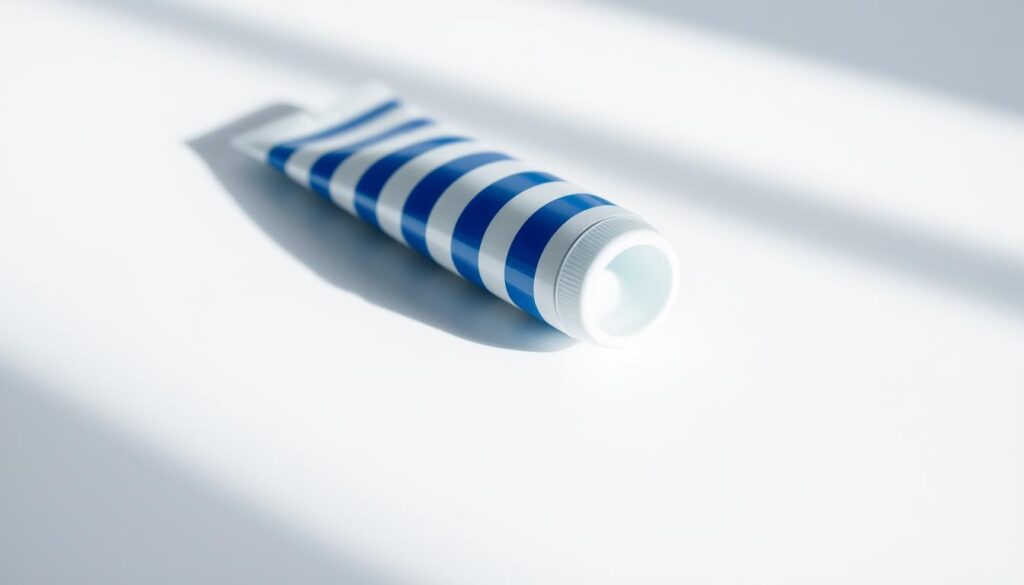
Importance of Professional Dental Hygiene
Experts can spot problems that home care misses. Hygienists use special tools to remove tartar and find gum disease early. This careful work helps keep your teeth and gums healthy.
Frequency of Dental Cleanings
Most people need cleanings every six months. But, some might need them more often. Here’s what clinics usually suggest:
- Adjusting schedules for patients with high cavity risk
- Encouraging preventive cleanings for those prone to gingivitis
- Discussing personalized plans based on medical history
Benefits of Regular Tooth Cleanings
Regular cleanings keep your breath fresh and protect your enamel. They also help prevent harmful bacteria from getting into your blood. Using toothpaste at home can add to these benefits.
Types of Toothpaste Used by Dental Hygienists
Professionals pick toothpaste that meets specific oral health needs. Each patient has unique requirements, like stronger enamel or stain protection. The right toothpaste is chosen along with tools like a dental scaler for cleaning.
Fluoride Toothpaste
Fluoride toothpastes, like Crest and Colgate, strengthen teeth and fight cavities. This mineral helps keep enamel strong and prevents tooth decay.
Whitening Toothpaste
Whitening toothpastes use mild abrasives and hydrogen peroxide. They gently remove stains without harming gums. Many people choose them for a brighter smile.
Sensitivity Toothpaste
Sensitivity toothpastes contain potassium nitrate or stannous fluoride. These ingredients calm nerve pain and protect dentin. They offer relief for those sensitive to temperature or sweetness. This, along with professional cleaning and a dental scaler, reduces discomfort.
Essential Tools for Dental Hygiene
Clinicians use both manual and electronic tools to remove tough plaque. These tools help get rid of plaque that builds up between visits. Comprehensive dental exams and cleanings often use many instruments for the best results.
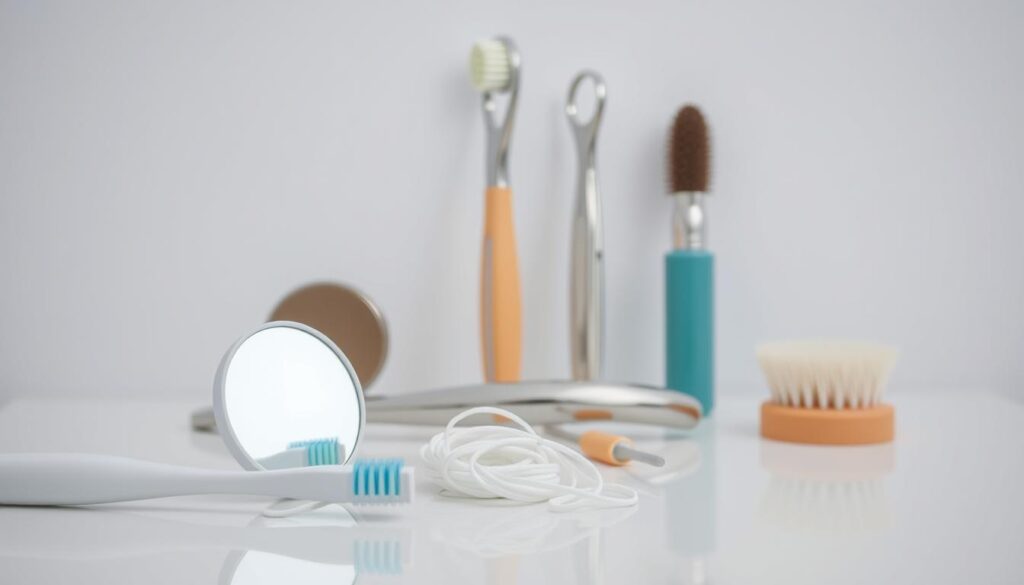
Scalers
Scalers remove hard tartar from teeth and near the gums. Their sharp tips get into tight spots where plaque hides. Many dentists choose stainless steel scalers for their strength and effectiveness.
Curettes
Curettes go under the gumline to remove hidden plaque. They help reduce swelling by cleaning out deep pockets where bacteria can hide. Curettes with rounded edges are softer on sensitive gums.
Ultrasonic Cleaners
Ultrasonic cleaners use vibrations to loosen plaque in hard-to-reach areas. This makes cleaning faster and easier. After using these cleaners, prophy paste is often used to polish the teeth and keep them smooth.
| Tool | Primary Function | Benefit |
|---|---|---|
| Scalers | Remove tartar above the gumline | Promote cleaner enamel |
| Curettes | Target deposits below the gumline | Less gingival irritation |
| Ultrasonic Cleaners | Disrupt plaque with pulsed vibrations | Minimize treatment time |
The Role of Prophy Paste in Dental Cleanings
Prophy paste is a special compound used to remove stains and smooth teeth. It’s often used as a final step after scaling. Some dentists use an ultrasonic scaler first to clean deeper without harming the enamel.
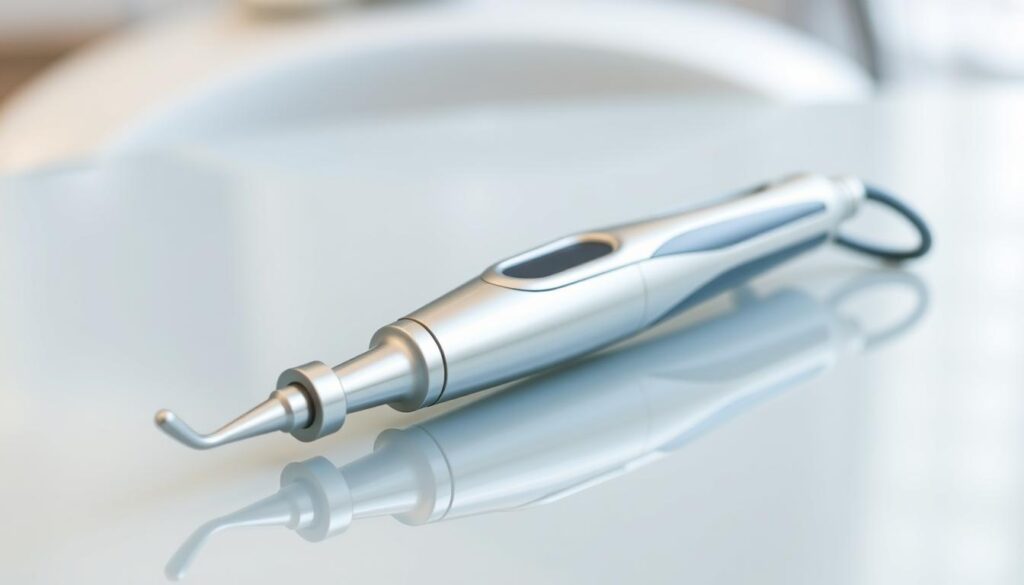
Types of Prophy Paste
There are different types of prophy paste for various needs. Fine-grit ones are for small stains. Medium or coarse ones are for bigger stains or buildup. They also come with ingredients to help sensitive teeth.
Benefits of Prophy Paste
Using prophy paste makes teeth look better and feel smoother. It helps prevent plaque from sticking. It also makes brushing at home easier. With regular cleaning and an ultrasonic scaler, prophy paste helps keep your mouth healthy and your smile bright.
Handpieces and Dental Equipment
Modern oral care uses efficient handpieces for tasks like tartar removal and finishing crowns. Experts focus on ergonomics and technical details to pick the right speed and torque. A dental mirror is key, helping to see hard-to-reach areas around teeth and gums.
Dental Handpieces
High-speed handpieces cut and shape quickly, with less heat buildup. Hygienists use low-speed ones with polishing cups for stain removal and surface smoothing. This method saves enamel and gives a smooth finish, improving dental health.
Accessories for Handpieces
There are many attachments to improve cleaning and restorative results. Some common ones are:
- Polishing brushes for fine-tuning surfaces
- Prophy angles for targeted plaque removal
- Burrs and disks for shaping restorative materials
These tools, along with a dental mirror, enhance visibility and precision. They help provide better patient care and long-term oral wellness.
Flossing Tools Used by Hygienists
Dental experts suggest different ways to clean between teeth. These methods aim to remove plaque and keep gums healthy. Choosing the right tool is important to ensure thorough cleaning and meet individual needs.
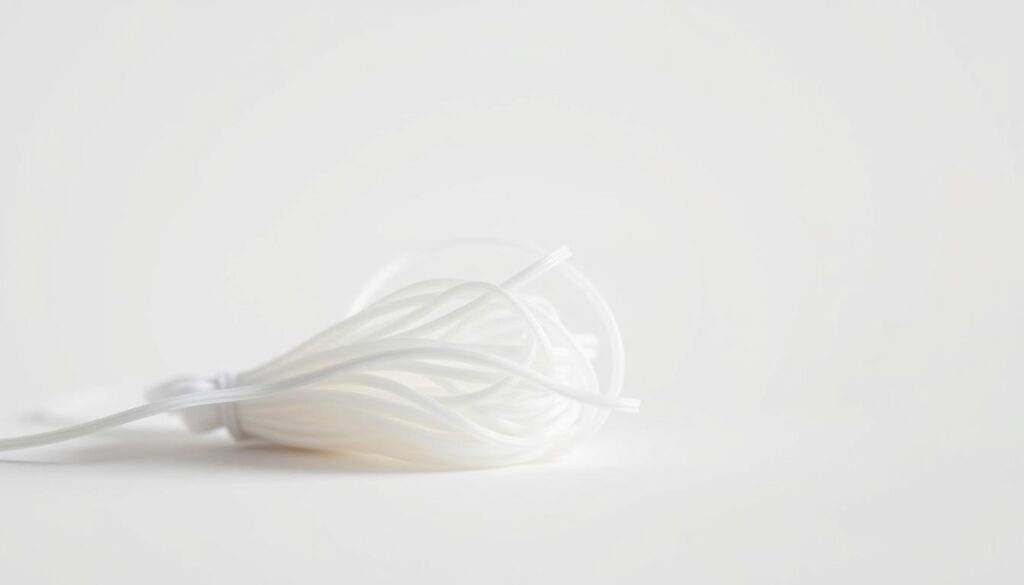
Traditional Dental Floss
Most dental offices use threads to clean areas brushes can’t reach. Patients learn to slide a thin thread under the gum line. This method helps avoid bleeding and keeps deep pockets from forming.
Many people use dental floss daily to protect their teeth and fillings.
Floss Picks
Floss picks make flossing easier by combining a string with a handle. They are great for those who struggle with traditional floss. Plus, they’re easy to carry around, making it more likely for people to floss regularly.
Water Flossers
Water flossers use high-pressure water to clean hard-to-reach areas. They are perfect for people with braces or implants. Regular use can reduce swelling and plaque.
For more information, check out dental check-ups and cleanings online.
“Rinsing alone does not replace flossing as targeted cleaning is key for gum health.” — American Dental Association
| Tool | Key Benefit |
|---|---|
| Traditional Floss | Removes plaque in tight contact areas |
| Floss Picks | Portable and user-friendly |
| Water Flossers | Ideal for orthodontic appliances |
The Importance of Personal Protective Equipment (PPE)
Clinic safety is key to preventing infections. Protective gear is a major defense against airborne particles and droplets. Dental professionals aim to create a safe space for both teams and patients.
High-speed tools, like an air polisher, can spread aerosols. Better protective gear cuts down on cross-contamination. This ensures a clean and trusted environment for everyone.
Masks and Gloves
Masks and gloves are vital for cleanliness. Masks catch droplets that might carry bacteria. Gloves prevent direct germ contact, keeping patients and staff safe.
Eyewear and Shields
Visual protection shields eyes from debris and fluids. It’s a safety net during treatments. This lets dental teams work accurately and safely.
Innovations in Dental Cleaning Technology
Modern dentistry focuses on precision and comfort. It uses special equipment to improve diagnosis and treatment. A dental prophylaxis tray is key, giving doctors quick access to tools that make care safer and more efficient.
Laser Dentistry
Laser technology removes unwanted tissue and bacteria with little harm to the area around it. This method speeds up healing and reduces pain. Many doctors see it as a big step forward in dental care.
Digital X-Rays
Digital X-rays take clear images that are easy to save and share. They help doctors spot problems early and plan treatments better. The low radiation makes regular check-ups safer. These images often go hand-in-hand with a dental prophylaxis tray, making patient care smoother.
Specialty Tools for Periodontal Treatment
Dental experts use special tools for periodontal treatment. These tools help them diagnose and treat gum problems carefully. They measure pocket depth and target infected areas.
Perio Probes
Perio probes are key in finding periodontal disease early. They help doctors check how deep the gums are around teeth. This lets them see if there’s inflammation and decide on the next steps.
Surgical Instruments
Surgical tools are used for tougher gum treatments. Doctors might use them to remove plaque, shape bone, or help gums attach back to teeth. Some important tools include:
- Bone chisels for reshaping irregular areas.
- Scalpel tips designed for delicate tissue handling.
These tools make each step easier. They help keep healthy parts safe and aim to prevent serious gum problems.
Materials for Patient Comfort
Patient comfort is key in dental hygiene. A calm place helps ease worries and makes regular dental visits easier. Protective steps also reduce fears about germs, making each visit safer.
Dental Bibs and Barriers
Dental bibs and barriers protect clothes from mess. They keep fluids in and prevent germs from spreading. These tools let hygienists keep the area clean while caring for the patient.
This careful method builds trust. It helps those who are nervous about dental visits feel more at ease.
Comforting Products
Some products are made to calm and comfort patients. They might include:
- Topical anesthetics to ease pain
- Gentle rinses for sore gums
- Distraction tools to make the visit more relaxing
These products help reduce stress and keep the area clean. They make patients feel more confident, encouraging them to keep up with dental care.
The Role of Mouth Rinses and Antiseptics
Mouth rinses help keep teeth and gums healthy by fighting common problems. They add an extra layer against plaque. Many have fluoride or antibacterial agents to strengthen teeth and fight early gum issues.
These rinses come in different types, each with its own purpose. Some make your breath smell fresh, while others help prevent cavities. Dentists help pick the best one for each person’s needs.
Types of Mouth Rinses
There are many types of rinses:
- Therapeutic ones cut down plaque and gum disease risks.
- Cosmetic rinses tackle bad breath and leave you feeling clean.
- Special ones help with sensitive teeth or dry mouth.
Benefits of Antiseptics
Antiseptics kill harmful bacteria, reducing problems and improving health. They’re great when used with dental cleanings. Studies show better oral health with regular antiseptic use.
Ergonomics in Dental Hygiene Tools
Keeping muscles healthy is key in today’s dental world. Doing the same wrist motion over and over can lead to tiredness and pain. Choosing the right ergonomic tools helps teams work better and stay safe from strain.
Importance of Ergonomics
Dental professionals spend a lot of time scaling, polishing, and checking teeth. Ergonomics helps keep wrists and shoulders in the right position. This can prevent long-term pain in the back, neck, or arms.
Changing up tasks and adjusting chair height can also help. These steps keep teams working well without getting tired.
Tools Designed for Hygienist Comfort
Companies like Hu-Friedy and Dentsply Sirona make tools that are easy to hold and don’t slip. The handles are textured to keep fingers from slipping. This makes it easier to hold the tools without putting too much pressure on fingers.
Tools with curved or angled shapes can also help. They make it easier to move your wrist. This helps keep your work precise and comfortable, even during long hours.
| Feature | Benefit |
|---|---|
| Textured Handles | Secure Grip |
| Lightweight Materials | Reduced Fatigue |
| Curved Design | Improved Wrist Alignment |
Maintaining and Sanitizing Dental Tools
Sterile instruments are key to reducing infection risks and keeping care quality high. By focusing on tool maintenance and sanitation, we prevent cross-contamination. This protects both patients and staff. For more on routine dental check-ups, visit this guide.
Cleaning Protocols
Many dental offices follow established sterilization steps. First, tools are rinsed and brushed to clear out debris. Then, autoclaving uses high-pressure steam to kill bacteria. Chemical processes apply germicidal solutions to finish the job. Staff members are careful to follow each step, ensuring they meet clinical standards.
Best Practices for Tool Care
Quality assurance begins with checking tools for wear and damage. Regular calibration ensures precision. Tools are stored in designated areas to keep them in good condition. Labeling trays and covering sharp instruments also helps prevent accidents. These steps make dental procedures smooth and build trust.
| Sterilization Method | Key Benefits |
|---|---|
| Autoclaving | High-temperature steam eliminates harmful microbes |
| Chemical Sterilization | Potent antimicrobial agents destroy resilient organisms |
Conclusion: Importance of Tools in Dental Hygiene
Good oral care starts with the right tools and materials. It’s all about safe practices and making patients feel at ease. Every tool, from ergonomic scalers to modern polishers, helps keep teeth healthy.
Summary of Essential Tools and Products
Colgate’s fluoride toothpaste strengthens enamel. Precision scalers remove plaque and prevent gum disease. 3M’s prophy pastes polish teeth for a smooth finish.
Water flossing makes daily care easier and gentler. These tools are key to a healthy smile.
The Future of Dental Hygiene Tools
New research brings better tools to dental care. Philips is improving ultrasonic tech for deeper cleaning without pain. Digital diagnostics and new materials are on the horizon.
These advancements mean better care for patients. They help achieve a healthy, confident smile.


